21 Most Common Types of Butterflies in Georgia (With Pictures)
-
Greg Iacono
- Last updated:
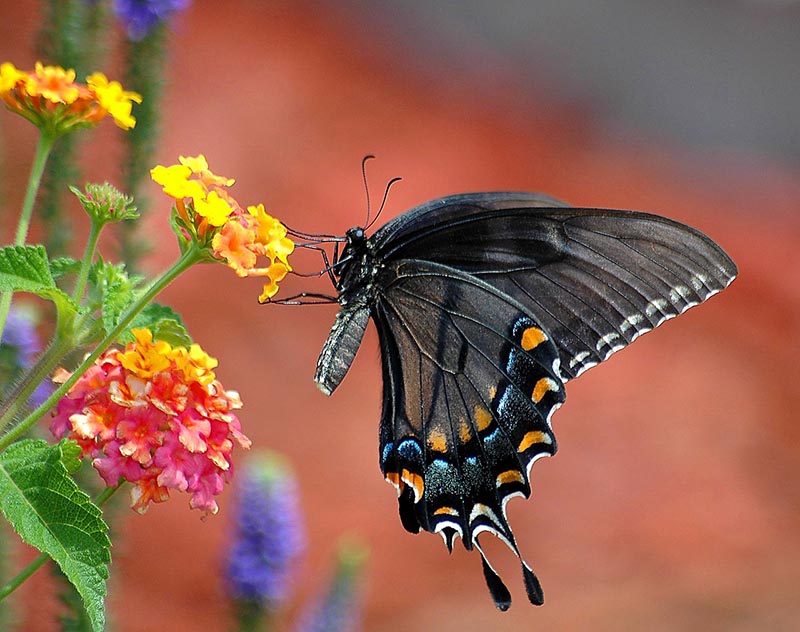
Butterflies are, without a doubt, one of the most beautiful species of insect. Butterflies come in a rainbow of different colors and sizes, and many have exquisite, colorful wings. In Georgia, USA, there are over 160 species of butterfly, and you can find many of them throughout the year. While we won’t look at all 160 of Georgia’s butterflies today, below are the 21 most common types you’ll find in the Peach State. If the beautiful butterfly is your passion or you’re curious about which ones you can find in Georgia, the information and pictures we’ve collected below will be very enjoyable.
The 21 Most Common Types of Butterflies in Georgia
1. Red Admiral

| Scientific name: | Vanessa Atalanta |
| Host Plant: | Nettles |
| Migratory: | Yes |
| Season: | Spring and summer |
The most widespread butterfly in Georgia is the Red Admiral, which you’ll find in forests and other moist habitats. With an impressive wingspan between 1.75 to 2.5 inches, these butterflies are relatively easy to spot. Their coloring makes it even easier, with a bright orange stripe on each wing, orange on the end of each wing, and white spots towards the top corners.
As a migratory butterfly, the Red Admiral flies south when winter comes to Georgia but returns every spring. To attract Red Admirals, place their favorite food in your yard, ripe fruit. You’ll find that they’re easy to approach and will often land on your arm or hand. When they do, be calm and still; they will stay there for a minute, allowing you to take in their beauty.
2. Monarch Butterfly

| Scientific name: | Danaus plexippus |
| Host Plant: | Milkweed |
| Migratory: | Yes |
| Season: | Early spring through late fall |
One of the most well-recognized species of butterfly, the Monarch, can be seen in Georgia from April through October. One reason they’re so well-known is that the Monarch butterfly has very large wings, which can be as wide as 4 inches. They also have a unique orange and black color pattern that many have compared to stained glass, with delicate white spots that outline almost the entire edge of each wing.
One fascinating fact about Monarch butterflies is that milkweed is their only food source, so if you want to attract them, you should grow milkweed in your backyard. If you’re lucky, you’ll spot massive groups of Monarchs as they travel south to Mexico for the winter. This is the species after which the ”butterfly effect” was named.
3. Viceroy Butterfly

| Scientific name: | Limenitis archippus |
| Host Plant: | Willow |
| Migratory: | No |
| Season: | Spring through early fall |
You might look at the Viceroy butterfly and think it’s the same as the monarch, but when viewed together, there are some subtle differences. The black line across the bottom of both wings on the Viceroy is the easiest to see, which the Monarch doesn’t have. The orange color is less bright, also, and the Viceroy has fewer white dots across the side and bottom of its wings.
While Monarch butterflies migrate, Viceroy butterflies do not. In the fall, Viceroy butterflies hibernate in the leaves of trees, sleeping away the winter in Georgia until they come out and become beautiful butterflies in spring.
4. Painted Lady Butterfly
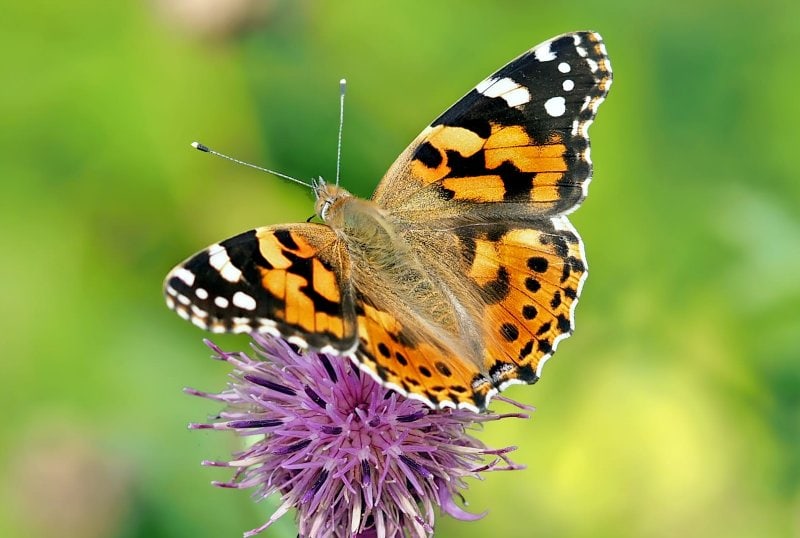
| Scientific name: | Vanessa cardui |
| Host Plant: | Malva |
| Migratory: | Yes |
| Season: | Spring and summer |
There’s no missing the Painted Lady butterfly, as this species has very distinctive markings on its wings. To find a Painted Lady, you’ll need to get off the beaten path, as they like quiet areas where they can go about their butterfly business undisturbed. In the fall, they migrate to Mexico. Painted Lady butterflies are medium-sized, with a wingspan that reaches about 2.5 inches.
One interesting fact about the Painted Lady butterfly is that it mates throughout the year and spends most of its time looking for suitable places to lay eggs. Their coloring has been compared to a giraffe, with brown and yellow markings that are eerily similar to the long-necked mammal. Also, don’t worry if you don’t see any Painted Ladies for a season or three, as they sometimes go away for a few, only to come back in even larger numbers.
5. Hackberry Emperor Butterfly
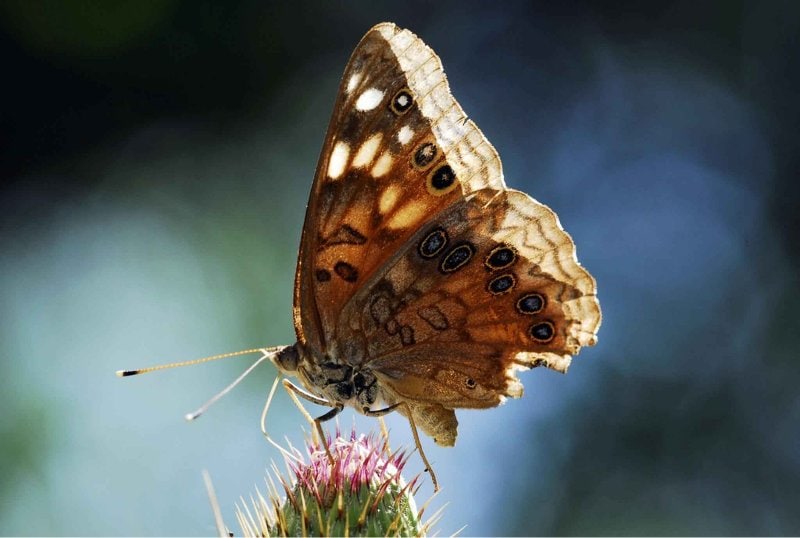
| Scientific name: | Asterocampa celtis |
| Host Plant: | Hackberry tree |
| Migratory: | Yes |
| Season: | Late spring through early fall |
Although many mistake them for a moth, the Hackberry Emperor is a genuine butterfly. You’ll spot Hackberry Emperor butterflies all over Georgia, typically in wooded areas, parks, and backyards, much to the delight of homeowners. This butterfly species is very curious and is known to land on humans.
However, researchers believe they do this because they get a lick of sodium from our skin. The Hackberry Emperor butterfly needs more sodium and minerals than most butterflies, which is why you often see them on the ground and rocks.
One unique fact about the Hackberry Emperor butterfly is that they don’t feed on flower nectar, a staple food for many butterflies. However, they eat some things other butterflies don’t, including tree sap, rotting meat, and animal feces. You’ll often see Hackberry Emperor butterflies in puddles, drinking rainwater.
6. American Lady Butterfly
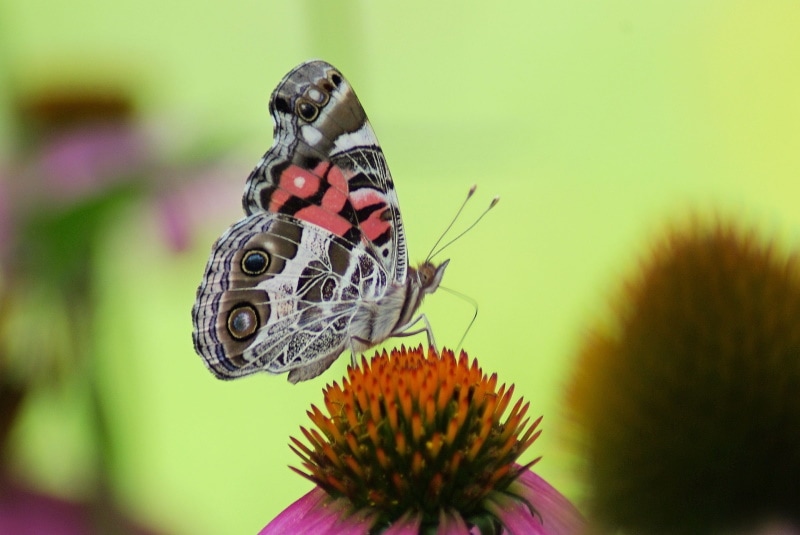
| Scientific name: | Vanessa virginiensis |
| Host Plant: | Sunflower |
| Migratory: | Yes, only northward |
| Season: | Spring through late fall |
Another medium-sized butterfly, the American Lady, can be identified by its purple spots near the edges of both wings. Another excellent way to identify this butterfly is to look underneath its wings, where you’ll see both “cobweb” markings and two large “eyespots.” The cobweb markings are incredibly delicate and unusual and set the American Lady butterfly apart from its butterfly cousins in Georgia.
If you see an American Lady butterfly, experts recommend you stay very still because it will fly away at the slightest provocation. Speaking of seeing, the eye spots we mentioned earlier are a defense mechanism that fools predators of the American Lady butterfly into thinking they’re looking at them. It’s a trait shared among several butterfly species and helps them survive in the wild.
7. Mourning Cloak Butterfly
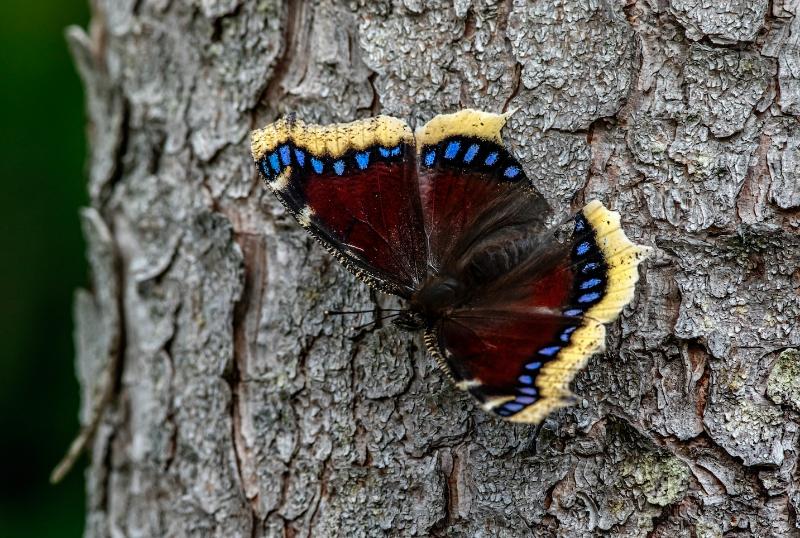
| Scientific name: | Nymphalis antiopa |
| Host Plant: | Willow, cottonwood, birch, elm |
| Migratory: | No |
| Season: | Early spring through late fall |
Mourning Cloak butterflies are said to be a herald of spring, so if you see one in your Georgia yard, spring is likely imminent or has recently sprung. The Mourning Cloak butterfly doesn’t migrate but instead hibernates during the winter. Although folks in Georgia love seeing them, those in Montana love the Mourning Cloak butterfly so much that they named it their state insect.
You’ll find Mourning Cloak butterflies on a wide variety of trees where they land to get a meal of tree sap. If you like hiking north of the Peach State, you’ll see Mourning Cloaks along the trails hanging upside down while they eat. With its exquisite purple-maroon color and tan-lined wingtips, this is one butterfly that’s hard to miss. However, if its wings are closed, you might walk right by it.
8. Cloudless Sulphur Butterfly
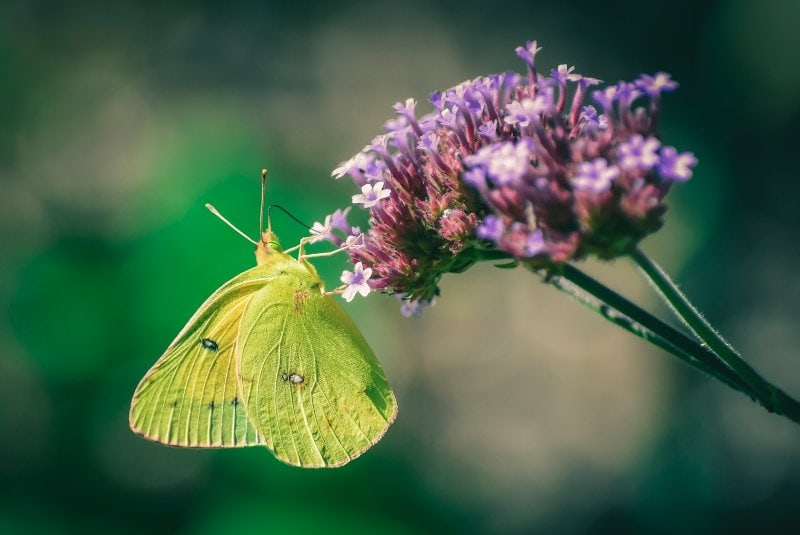
| Scientific name: | Phoebis sennae |
| Host Plant: | Senna |
| Migratory: | Yes |
| Season: | Winter |
The Cloudless Sulfur is a very common butterfly in Georgia, especially in winter. Not only is this butterfly species common, but it’s also one of the easiest to spot, thanks to its shockingly bright yellow color. However, their wings aren’t all yellow, as they have a sprinkling of small magenta lines and occasional white spots. A delicate black border is also found along the edge of the Cloudless Sulphur butterfly’s wings.
If you want to see this beautiful butterfly, you should plant several types of flowers in your yard for them to land on and have a snack. Unfortunately, it’s getting harder to spot Cloudless Sulphur butterflies because human development has severely impacted their habitat. Luckily, the Cloudless Sulphur butterfly hasn’t been put on the threatened species list… yet.
9. Spicebush Swallowtail Butterfly

| Scientific name: | Papilio troilus |
| Host Plant: | Spice bush, sassafras, camphor tree |
| Migratory: | No |
| Season: | Early spring to mid-fall |
If you want to see butterflies in fall and winter in Georgia, the Spicebush Swallowtail butterfly is a great choice. They can hang around in winter much better than other butterflies due to their unique trait. That trait? The Spicebush Swallowtail butterfly can regulate its body temperature using the color of its wings, staying warm when the weather gets colder.
To attract the Spicebush Swallowtail butterfly to your Georgia backyard, try planting azaleas, one of the nectar-producing plants it loves most. You could also plant the bush that gave the Spicebush Swallowtail butterfly its name, the spicebush. As far as spotting this lovely butterfly species, it’s relatively easy. Their dark blue, almost black wings with lovely cream-colored spots along the edges set them apart, along with a splash of bright blue towards the wings’ rear.
10. Banded Hairstreak Butterfly

| Scientific name: | Satyrium calanus |
| Host Plant: | Chestnut oak, white oak, American chestnut |
| Migratory: | Short distance |
| Season: | Early summer to mid-fall |
The Banded Hairstreak is a smaller butterfly species with a wingspan of 1.25 inches or slightly less. However, what it lacks in size, it makes up for in unique color patterns. The Banded Hairstreak butterfly’s light brown fades into slate gray, with a delicate black border on its wings. A little further in is a wide band of reddish-orange with a white border. In short, it’s very colorful and, although small, it’s hard to miss.
Look closely for Banded Hairstreak butterflies in your yard because they’re only active for about 4 weeks, usually in the early part of summer. To attract them is easy; all you need are some oak, walnut, or hickory trees, and they’ll be all over the place! A few nectar-producing plants like dogbane and meadowsweet will help, as Banded Hairstreak butterflies love feeding on nectar.
11. Eastern Tailed-Blue Butterfly
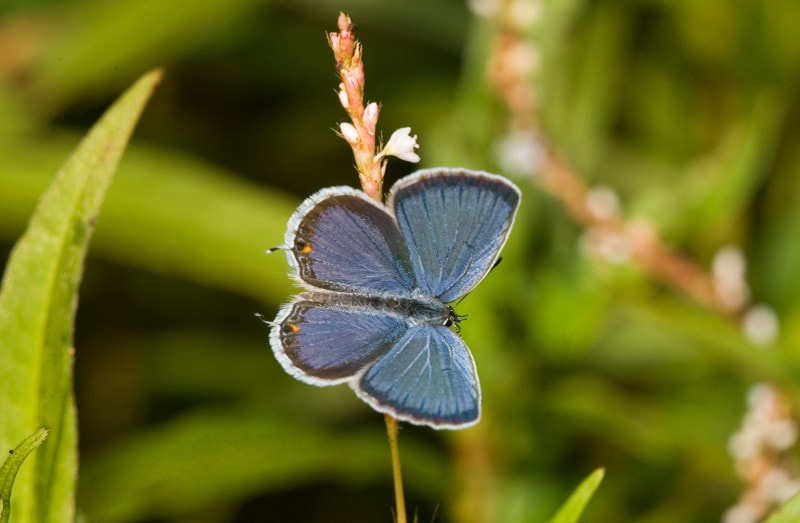
| Scientific name: | Cupido Comyntas |
| Host Plant: | White and red clover, beans, wild pea |
| Migratory: | No |
| Season: | Spring through early fall |
Although very small at less than an inch when its wings are spread, the Eastern Tailed-Blue butterfly is one of the most striking due to its gorgeous magenta color and thick, black edges on its wings. This butterfly species has more sexual dimorphism than most, as the female’s coloring is much different from the male’s. They are grayish-brown and have white edges on their wings with several lines of black spots.
One way to tell if you’ve spotted an Eastern Tailed-Blue butterfly is to spot the small tails on the back end of both wings. However, you might not see them as they can break off easily. You can also tell by looking underneath their wings, as the Eastern Tailed-Blue butterfly is silvery-blue underneath. Both male and female Eastern Tailed-Blue butterflies have orange spots just above their wing tips.
12. Gray Hairstreak Butterfly

| Scientific name: | Strymon melinus |
| Host Plant: | Bush clover, clover, beggar weeds |
| Migratory: | No |
| Season: | Early spring to late fall, early winter |
Georgia has millions of acres of pastureland, where the Gray Hairstreak butterfly will likely be seen. Various plants are hosts for the Gray Hairstreak butterfly, so pastures, rural meadows, and even overgrown roadsides are very attractive to them.
One way to tell if you’re looking at a Gray Hairstreak butterfly is its specialized wing tail, which is one of the longest in the butterfly family. These wing tails look like antennas and are a fantastic defense mechanism as it seems like they’re looking at birds, their main predator. While the bird is confused, the Gray Hairstreak escapes!
13. Common Wood-Nymph Butterfly
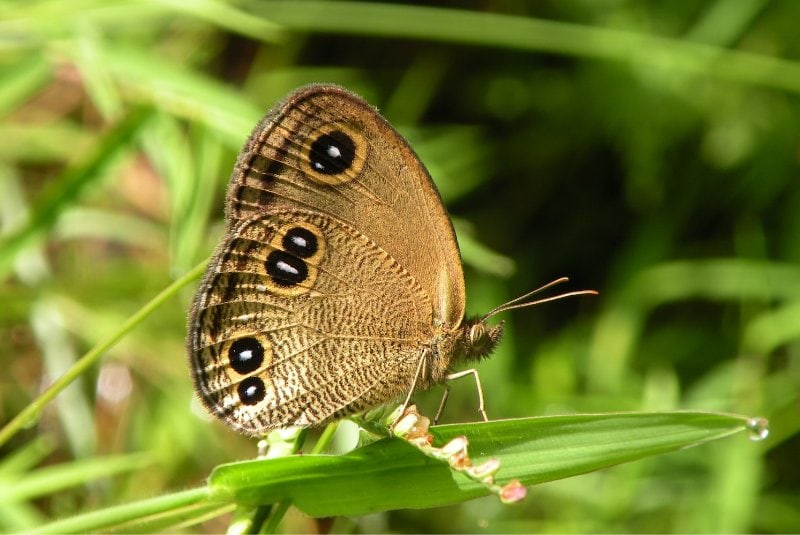
| Scientific name: | Cercyonis pegala |
| Host Plant: | Butterfly weed |
| Migratory: | No |
| Season: | Mid-spring to late fall |
Many people are under the impression that the Common Wood-Nymph butterfly is a moth, but it is indeed a butterfly. One reason for the confusion is that the Common Wood-Nymph butterfly’s coloring can vary significantly from one butterfly to another. These are giant butterflies with wingspans that can reach upwards of 3 inches, so they’re relatively easy to spot.
Unlike many other butterflies in Georgia, the Common Wood-Nymph butterfly is most active in late summer. Another big difference between these butterflies and the others in Georgia is that their host plant is grass, the butterfly weed. They also have a penchant for Kentucky bluegrass (although you won’t find much of that in the Peach State).
14. Little Wood Satyr Butterfly
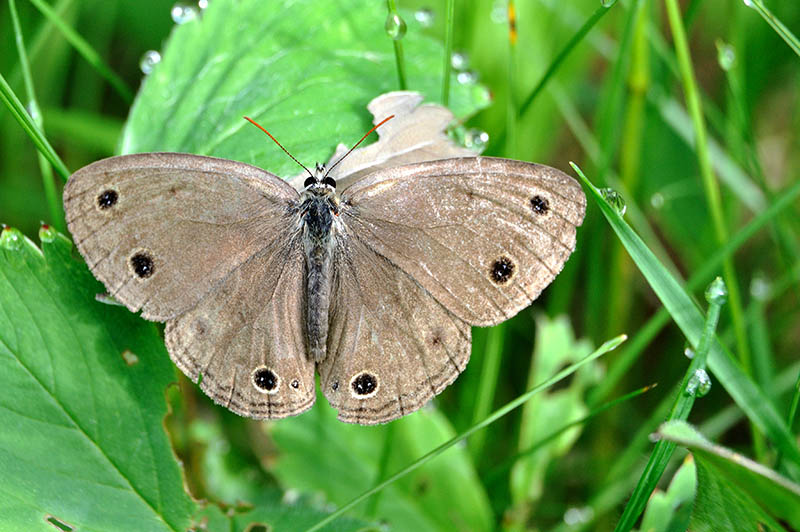
| Scientific name: | Megisto cymela |
| Host Plant: | Orchard and centipede grass |
| Migratory: | No |
| Season: | Early to late spring |
While you might enjoy seeing the Little Wood Satyr butterfly in your backyard, attracting it with its favorite food isn’t recommended. That’s because this butterfly likes eating poop and rotting mushrooms, two things you wouldn’t want to put in your yard on purpose; they don’t eat any nectar. Little Wood Satyr butterflies like to hang around leaf litter, so keep some from last season around the edge of your yard.
Spotting the Little Wood Satyr is relatively easy as they have six to eight eyespots on the top of their wings. Their wingspan isn’t huge at 1.5 to 2 inches, but they aren’t small either. The Little Wood Satyr butterfly doesn’t migrate but hibernates in Georgia, and you’ll only see it in early to late spring.
15. Great Spangled Fritillary Butterfly
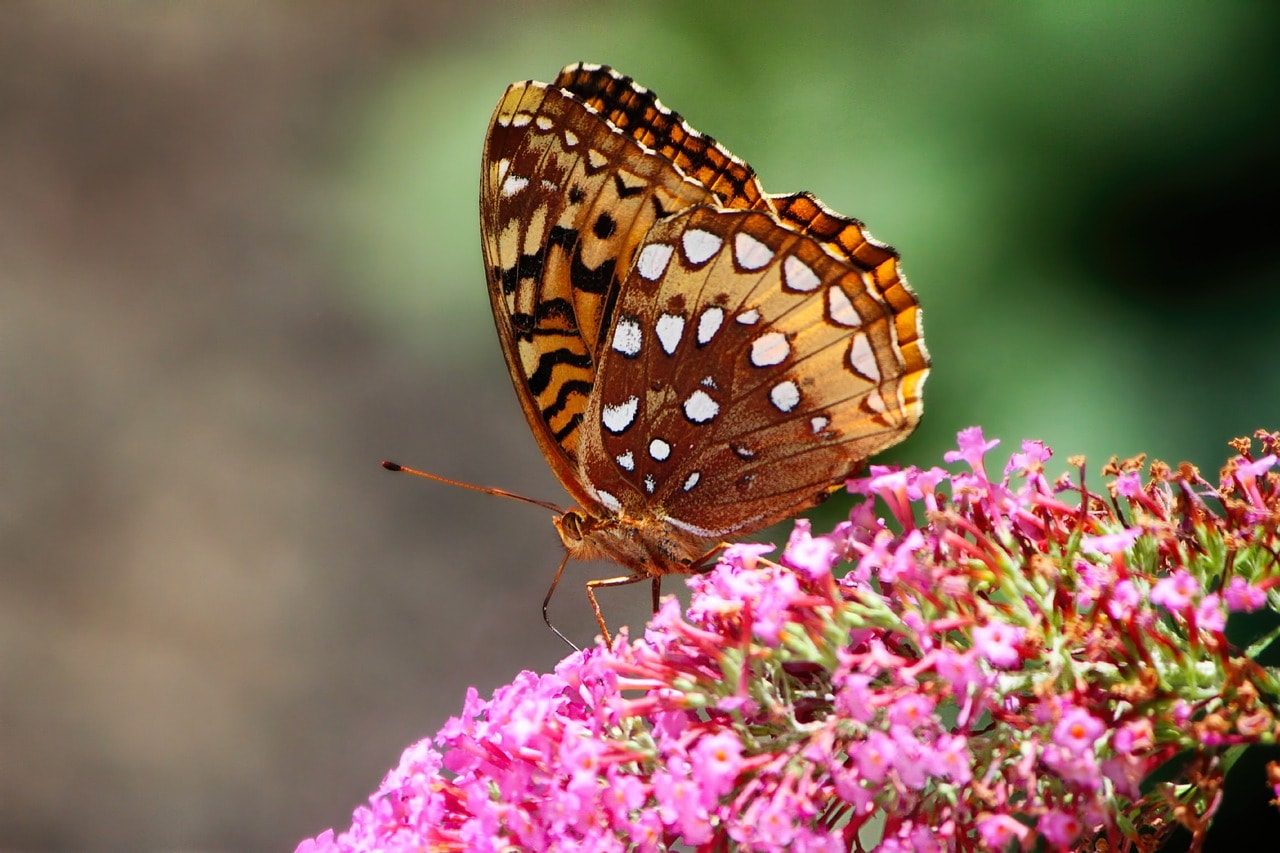
| Scientific name: | Speyeria cybele |
| Host Plant: | Violet |
| Migratory: | No |
| Season: | Mid-summer to early fall |
The Great Spangled Fritillary is one of the most strikingly beautiful of all the butterflies in Georgia. They have a large wingspan of up to 3.5 inches and, on their wings, a delicate pattern of silvery-white spots with orange and black lines. That makes them relatively easy to spot in their favorite habitat: open fields, meadows, and pastures. If you’re lucky, you’ll see hundreds of them gathered together in fields of violets, their host plant, and milkweed.
Like several other Georgia butterflies, the Great Spangled Fritillary doesn’t migrate but hibernates during winter. When violets bloom in spring is when they reappear, letting you know that the seasons have changed. One interesting fact about this butterfly is that the males die several weeks before the females, right after mating. The females stay a few weeks longer to eat, gain weight, and lay their eggs.
16. Common Buckeye Butterfly

| Scientific name: | Junonia coenia |
| Host Plant: | Snapdragon, gerardia, foxglove |
| Migratory: | Partial |
| Season: | Late spring to early summer |
Spotting the Common Buckeye butterfly in Georgia is a breeze thanks to the various massive eyespots on their wings that are truly spectacular. They’re outlined in black and have an inner iris of purple, orange, and green. The rest of their body is mostly brown, but those eyespots turn the Common Buckeye butterfly into one of the prettiest in the state. You’ll find this colorful butterfly in pastures, fields, and along Georgia roadsides.
The Common Buckeye butterfly stays in Georgia year-round and reproduces the entire time. They are partially migratory in that Common Buckeye butterflies in the northern part of the US come down to Georgia and other states in the winter. You might not be able to get too close to one, but once they land, taking photos of a Common Buckeye butterfly is easy since they generally stay in one spot for a long time unless spooked.
17. Question Mark Butterfly
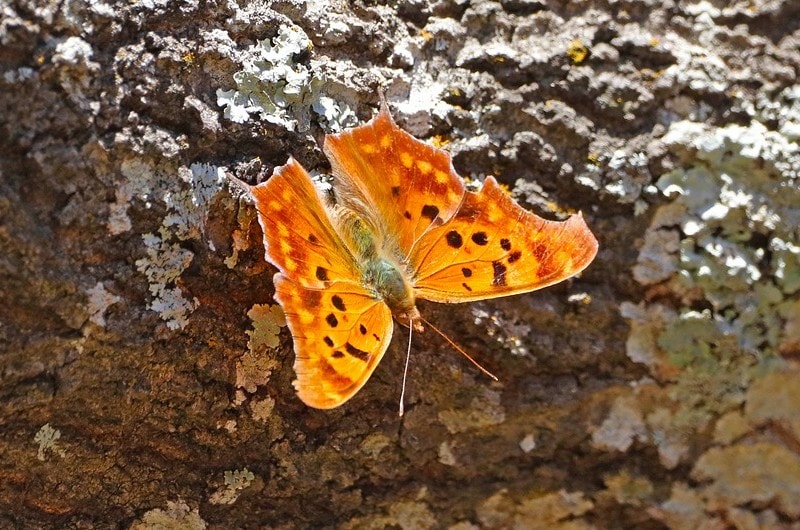
| Scientific name: | Polygonia interrogationis |
| Host Plant: | Nettles, elm trees |
| Migratory: | Partial |
| Season: | Late winter to early fall |
Another gorgeous butterfly found in Georgia is the Question Mark butterfly, which has rather uniquely shaped and large wings up to 3 inches. At the top of its wings, the Question Mark butterfly is bright orange with multiple black spots. On the lower half, the coloring changes to a blotchy brown color, which helps them avoid predators by resembling dead leaves in the fall.
The Question Mark butterfly gets its name from a tiny marking located on the underside of its wing, which, if you squint, looks kind of like a question mark. The best place to see this lovely butterfly would be in an elm forest, although they love nettles also and will often be found on them.
18. Eastern Comma Butterfly

| Scientific name: | Polygonia comma |
| Host Plant: | Nettles and elm trees |
| Migratory: | No |
| Season: | Early spring through early fall |
One of the fascinating facts about the Eastern Comma butterfly is that, instead of hibernating as a caterpillar, they hibernate as fully-grown adults. Typically, the Eastern Comma butterfly will search for piles of logs, dead trees, and other similar areas to hibernate and stay safe during Georgia’s relatively mild winter. The adults emerge and mate in spring, and a new generation can be seen in late May.
Like several other butterflies on today’s list, the Eastern Comma butterfly doesn’t eat nectar but prefers rotting flesh, poop, and fruit. That means you should attract it to your yard at your own risk. However, these appealing butterflies are prevalent in Georgia and other southern states, so attracting them to your yard might not be necessary.
19. American Snout Butterfly
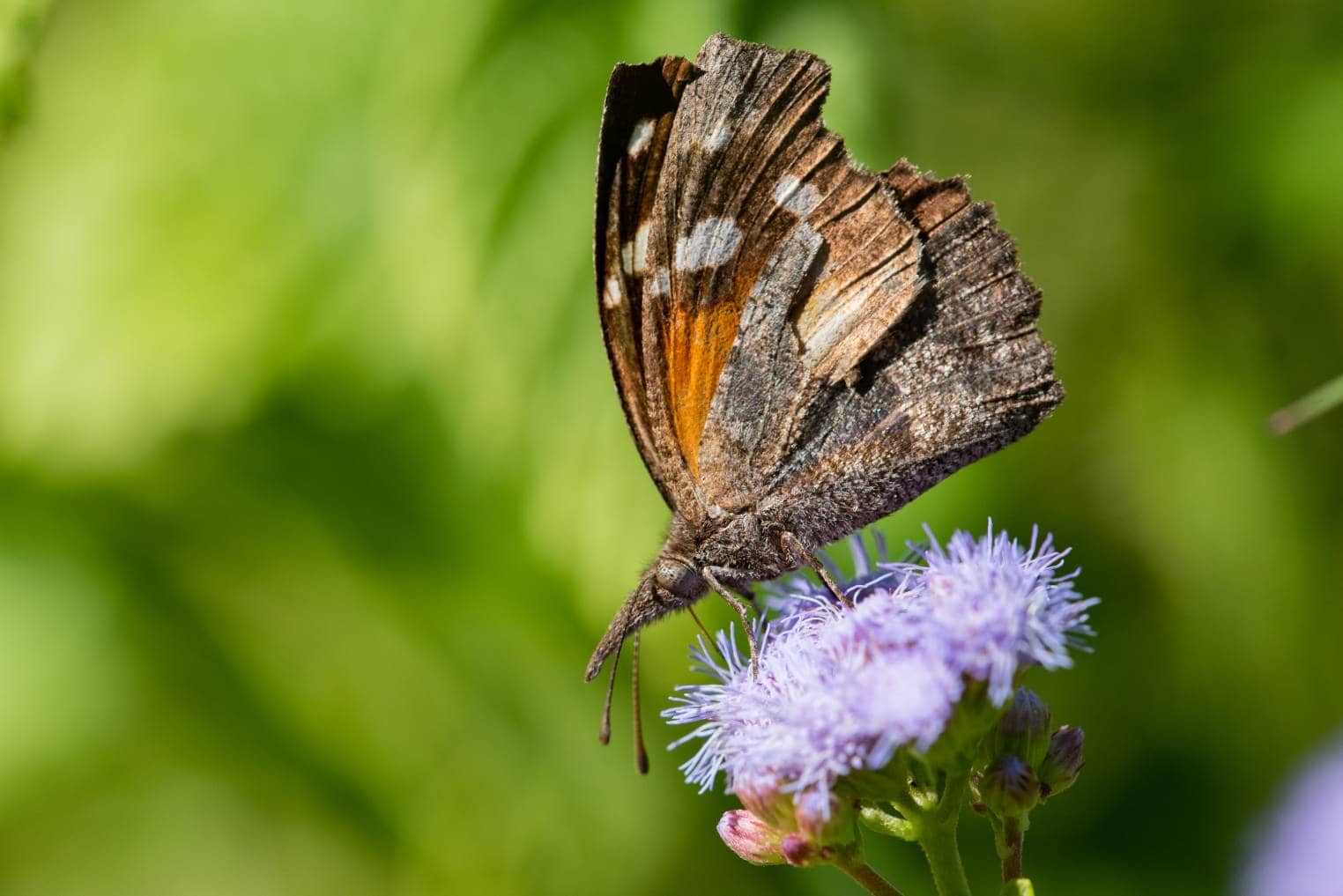
| Scientific name: | Libytheana carinenta |
| Host Plant: | Spiny hackberry tree |
| Migratory: | Sort of |
| Season: | Spring through fall |
Unique is a great word to describe the American Snout butterfly, as it is the only one in Georgia with a proboscis! Like many odd traits about butterflies, this defense mechanism allows them to look like dead leaves and escape predators. It also makes them difficult to spot.
Another fascinating trait the American Snout butterfly possesses is that, although they migrate, it’s not in the usual “north in summer, south in winter” manner. It’s more of an “emergence,” with the butterflies flowing together in massive groups that, in some years, can blacken the sky. They might go north or south, but they don’t follow any particular pattern. When open, the wings on the American Snout butterfly are beautiful, with bright orange coloring. Closed, though, they look more like a dead leaf.
20. Azure Butterfly
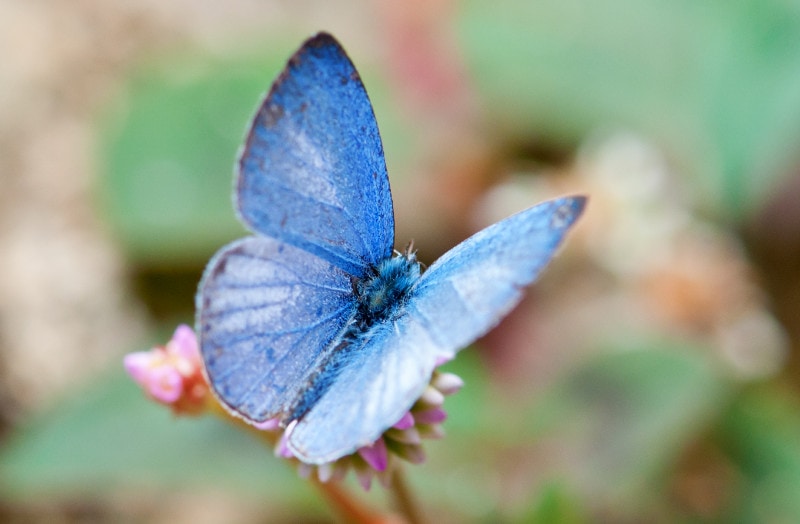
| Scientific name: | Celastrina ladon |
| Host Plant: | Flowering dogwood |
| Migratory: | No |
| Season: | Early spring to mid-summer |
If blue is your favorite color, you’re bound to adore the Azure butterfly. Their wings are, not surprisingly, a lovely azure blue, but they’re small at only 1.25 inches wide. Around the top of their wing tips are large black areas, and the rest of their wings have a thick black outline, making the Azure butterfly stand out among the flowers with nectar it likes to eat. You’ll also see several black spots on the bottom of its wings.
The Azure butterfly is abundant in Georgia, mostly along open woodlands, hiking and biking paths, and the edges of arboreal forests. There are also three subspecies of the Azure butterfly: the Appalachian Azure, the Summer Azure, and the Dusky Azure, all three of which can also be found in the state.
21. Black Swallowtail Butterfly
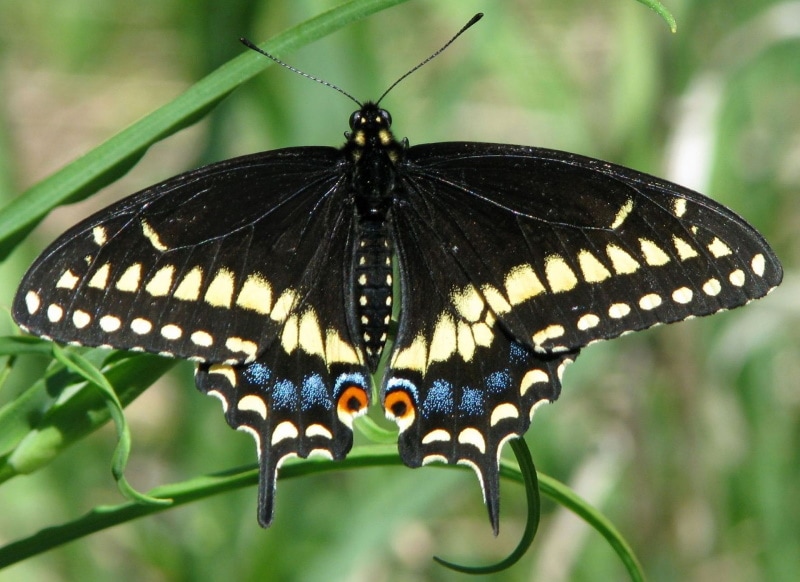
| Scientific name: | Limenitis archippus |
| Host Plant: | Carrots, parsley, dill, fennel |
| Migratory: | No |
| Season: | Spring through late fall |
The shape of the Black Swallowtail’s wings is a dead giveaway that you’ve spotted this attractive butterfly, as they are unique. Wide at the top, they taper in towards the bottom, and the Black Swallowtail butterflies’ body is shorter than most. The coloring of their wings is jet black at the top, and they have two rows of white spots down the sides with a row of azure blue spots in between.
Black Swallowtails are one of the most common butterflies in Georgia and can be seen throughout the state. They have a propensity for nectar, so if you want to attract them to your yard, be sure to plant plenty of pretty nectar-producing flowers. Be careful with your garden herbs because Black Swallowtail caterpillars will munch on your mint and partake of your parsley.
How to Attract Butterflies to your Georgia Yard
If attracting some of the butterflies you’ve seen today to your Georgia backyard is your goal, the following tips will be very helpful.
Grow Nectar-Producing Plants in your Yard
Like all creatures, butterflies need to eat; one of their favorite foods, at least for many, is nectar. Attracting butterflies to your yard thus means you need to grow plants that produce nectar. Some of the best to grow in the Peach State include the eastern purple coneflower, winter honeysuckle, Mexican sunflower, buttonbush, and aster. Also, many of the butterflies in Georgia love milkweeds, so planting milkweed is suggested.
Don’t Use Chemicals or Pesticides on Your Plants or Garden
Although they’re gorgeous and certainly don’t look like insects, that’s exactly what butterflies are. If you spray pesticides on your plants and flowers, you’ll kill insect pests and, sadly, butterflies too. In short, if you want butterflies to beautify your yard, put the chemicals and pesticides away.
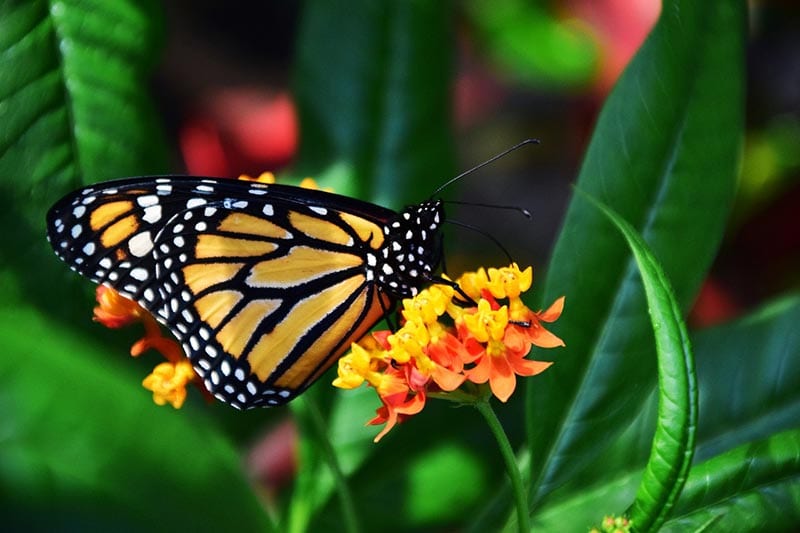
Put Plants in the Sunniest Part of your Yard
Have you ever noticed that you don’t see many butterflies on cloudy days? That’s because they need to warm up their wings in order to fly, and they can’t do that without sunshine. Knowing this, you should put any plants you use to attract butterflies in the sunniest part of your yard. Keep in mind that the size of your garden doesn’t matter. Even a few nectar-producing plants in pots on your patio will attract butterflies.
Plant Host Plants in your Yard
Host plants are the plants that butterflies use to lay their eggs. Most butterfly species will only lay their eggs on certain host plants, including milkweed, Queen Anne’s Lace, fennel, passion vine, aster, black-eyed Susan, false nettle, hollyhock, silver brocade, and sunflowers. You can also plant herbs like dill, fennel, and parsley to attract butterflies.
Some of the trees that butterflies lay their eggs on include the American elm, aspen, and flowering ash, as well as the flowering dogwood, oak tree, hackberry, and paper birch. Lastly, there are grasses you can plant, including Bermuda grass, Kentucky bluegrass, orchard grass, and switchgrass, among others.
Final Thoughts
As we’ve seen today, Georgia is home to several beautiful butterflies, and spotting many of them is relatively easy. Many plants, flowers, and grasses that grow in Georgia are perfect for butterflies and attract them in droves. Being one of the biggest states in the United States, Georgia also has plenty of pasturelands, forests, and open fields where butterflies like to congregate, mate, and prosper.
If you’re a big fan of butterflies and live in Georgia, you’re definitely in luck, as many of them call the Peach State home. Best of luck spotting your favorites the next time you’re out exploring, hiking, biking, and boating!
Featured Image Credit: Paul Brennan, Pixabay
Contents


